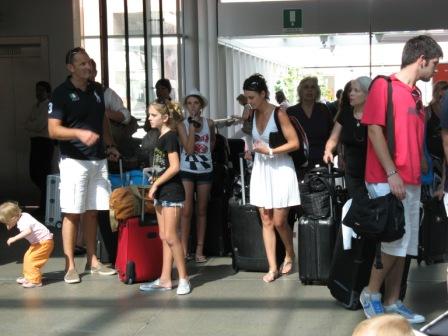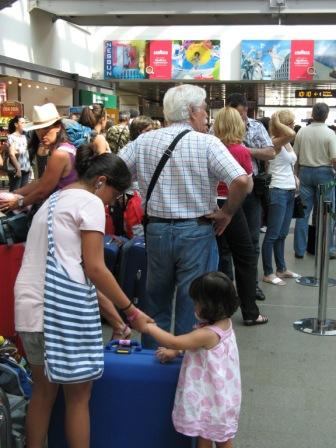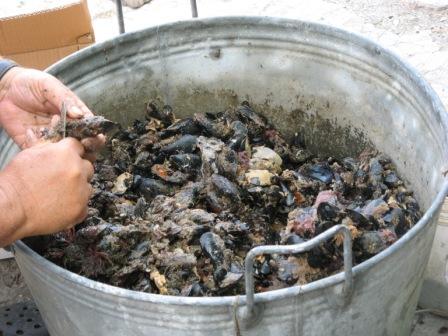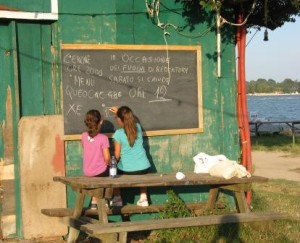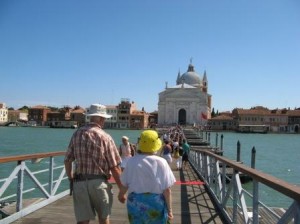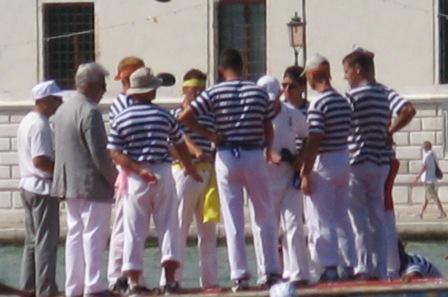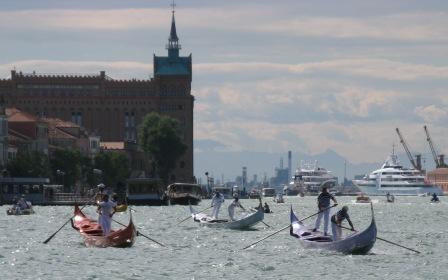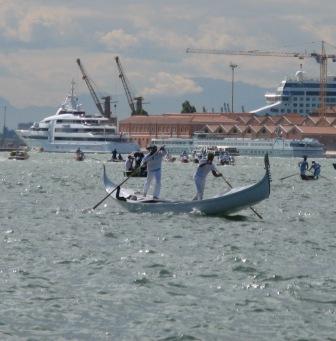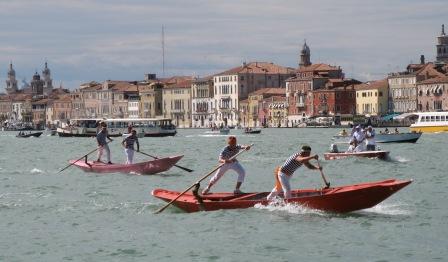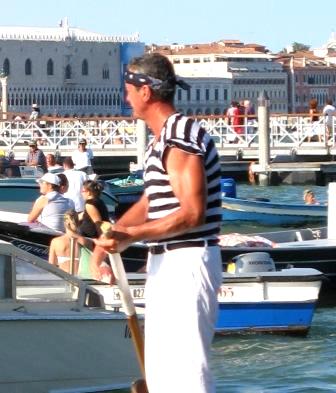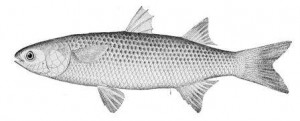Preposterous, ludicrous, and any other “ous”ly things that come to mind can happen all year long. But either the summer seems to produce more of them, like tomatoes and zucchini, or we’re more in the mood to read about them.
Here are some tidbits from the recent past, as reported by the faithful Gazzettino:
“THE FAMILY JEWELS IN THE BADANTE’S CAKE”
(Note: A “badante” is a paid caretaker, usually living with a little old person in need of assistance. They are mostly women, and mostly from Eastern European countries, not that that matters particularly to this or any other story).
“They wanted a piece of cake and instead they found a treasure. Too bad the treasure was already theirs and the cake was destined for somebody else. This is the grotesque misadventure of two residents of Castello, a mother and daughter, in what was supposed to be an ordinary domestic afternoon.
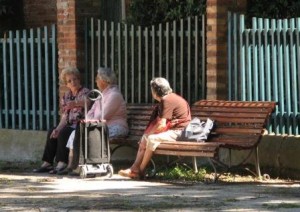
The culprit was a 50-year-old Polish woman who has been living in the district for some years….
“She seemed like a good person [said the daughter]; she stayed with my mother all day, sometimes she even spent the night. I trusted her completely from the very first; she did the shopping and cooking, and would take my mother out for walks.”
But one day the badante asked for money to buy the ingredients for two apple-cakes she wanted to make — one for the family, and one to send to her own people back in Poland. And so the cakes were made, and one was sent off to Poland.
The following afternoon — the badante’s day off — the mother and daughter decided to taste the cake…..which turned out to be fairly difficult to cut. “It seemed like cement,” said the daughter.
Then the discovery: In place of the apples, the cake was full of her mother’s jewelry, necklaces and rings of gold. “There was even my baptism necklace.”
The other cake had been sent to Poland by mistake.
It was an exquisite plan — the only thing lacking was execution. After all, there were only two cakes — it’s not as if there were hundreds to keep track of, like M&Ms. Anyway, that was the scene: What a lovely cake, let’s have tea and a large piece. The daughter takes the knife and cuts into it. Crunch. (Crunch?) And out come her mother’s 18-karat bibelots. Like party favors, only, you know, not. Not at all. I’m not sure how you say “D’oh!” in Polish, but the badante is probably going to be saying it for quite a while. If not to herself, to her folks back home who cut into their cake, imagining all the things they were going to buy with the money arriving via Betty Crocker, and who came up with nothing but jam and chopped walnuts.
I’m not sure which scene I’d rather have witnessed: The cutting of the wrong cake (either one), or the unsuspecting badante’s return home that evening. Not to mention the phone call from her family.

“A TOOTH IN HER LUNGS MAKES HER SUFFER FOR 24 YEARS”
“Instead of swallowing it, which would have been simpler, luck would have it that the little girl unconsciously inhaled her milk-tooth molar, which had come loose, at the age, presumably, of 10 or 11. She didn’t realize [that she had done this], but soon afterward began to complain of a pain in her lungs. It would come and go, more or less frequently, more or less intensely, up until a few days ago. Today the little girl is a 34-year-old woman, married and the mother of two children. And by chance the other day, the pain having returned, she had a bronchioscopy and the cause was discovered: a milk tooth. An intervention at the hospital at Dolo [16 miles from Venice], one good cough, and out came the tooth which had caused so much pain for so long.”
What makes me wonder about this woman isn’t that she inhaled her tooth — I suppose it could happen to anyone. What I can’t grasp is that she lived 24 years without investigating further. Did she think everybody has a pain in their lung? Did she never wonder about it at all? Or does it take that long to get an appointment at the radiologist? And if one of her children had a pain in his/her lung, would she have just said “Suck it up” (sorry) and leave it at that? I couldn’t put up with 24 years of anything, if I didn’t know what it was. Evidently curiosity went to Dolo to die.
“130 CITATIONS FOR TWO BARRELS”
There is a very cool restaurant in the Campiello del Remer, not far from the Rialto Bridge. It’s called Taverna Campiello del Remer and I can remember when this campo was pretty desolate. So I was glad to see that improvements began to be made a few years ago by unseen hands. The main accomplishment was the fixing-up of a brick vaulted former warehouse (it would appear to have been) to become this congenial little eatery. But there is no joy in the Campiello del Remer, because the police won’t stop giving the restaurant owner summonses.
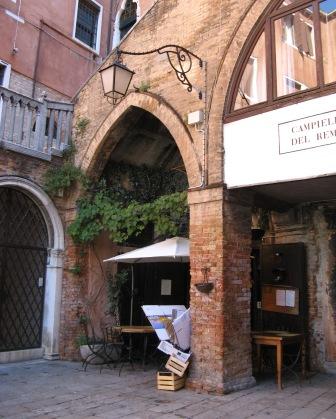
The nub of the problem is that commercial enterprises which occupy public space (think cafe tables on the sidewalk), have to pay a special tax. The space they are allowed to occupy is measured out and a record of these dimensions is kept in one of the city offices.
Emilio Farinon and Angela Cook, owners of the joint, put two big old wooden barrels (closed at both ends) outside the entrance. These barrels were intended to be useful as little tables where people could put their drinks and their ashtrays, much better than putting this stuff all over the ancient marble wellhead in the courtyard.
But somebody in the Campiello del Remer objects to the casks and has decided they must be removed because they are occupying public space illegally. (It’s really heartwarming to find that there is someone who takes the letter of the law so seriously around here. I wonder what they do for fun?). And so this person has taken to calling the police to come write out summonses for the alleged violation. This has happened 130 times in one year.
But not so fast, says Giorgio Suppiej, the owners’ lawyer. This is persecution, and a baseless one, because the square inches of soil upon which the hogsheads are sitting isn’t public, but private. So the summonses have no validity.
To demonstrate this fact, Suppiej has shown the Comune as well as the Court the Napoleonic Cadastre, the first ever to document the property limits of every building in the city. Suppiej then compared it to the subsequent version, and finally the one that is current today. “In all of the maps,” he says, “the space, which is under a staircase, is shown as private.
“Furthermore, the Comune can’t say the space is public; we previously asked the Comune to grant the plateatico [authorization to use public space], a request which was rejected because the space is under a staircase, a rejection which was suspect because other spaces beneath a sottoportico [passageway under a house] have been granted the plateatico, and anyway, this isn’t a sottoportico, but a sottoscala [under a staircase].”
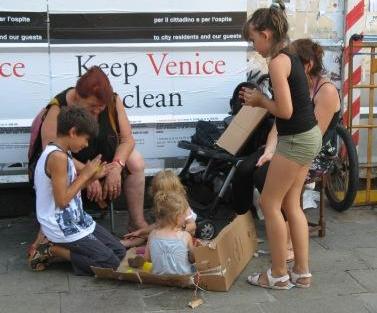
A city councilor, Renato Boraso, has added his booming notes to the chorus, and asked the mayor to justify what Boraso regards as the “excessive zeal” of the municipal police. [Didn’t know they were prone to attacks of zeal, much less excessive ones. This is heartening indeed.]
“One hundred thirty citations isn’t something to underestimate,” he says. “…It’s time to put an end to this persecution — we’ve reached administrative insanity and I’m going to ask for all the documentation and then send it to the Accounting office. The city is going to have to justify all the hours which the police have spent on pursuing the complaint of a private citizen who evidently knows somebody at City Hall, distracting them from their public duties.
“Furthermore, it appears to me that the night that those vandals tried to set fire to Marino, the old derelict, the police were in the office writing out their usual photocopied report on this.” I like this, not only because it shows the vivid contrast in importance between an attempt on someone’s life and a bureaucratic technicality, but because it implies that there were only two police on duty that night in the entire city. But I mustn’t get distracted.
Ernesto Pancin, head of the merchants’ association, also sees some anomalies in this conflict. “I believe that businessmen ought to be rewarded, not punished, for their tenacity. In the case of the Campiello del Remer, before a business was established there, there were only drug addicts. I can guarantee that there are other cases which are flagrantly illegal but which inexplicably go unpunished.”
The Battle of the Barrels may, with all this publicity, have reached a turning point. Perhaps the anonymous protester will turn to pursuits of more evident public value, though I doubt it because this vendetta doesn’t have any significance to anyone but him or her. But if they’re still in the mood for persecution, I have a little list of offenses here that he or she could start on tomorrow. I could help.
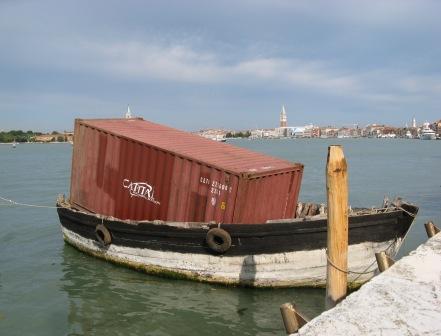

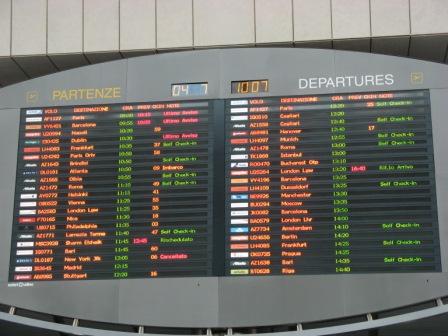
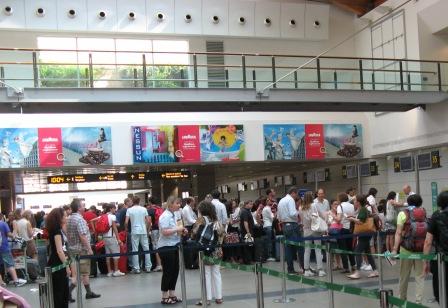
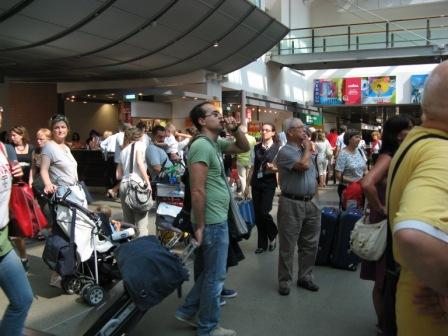

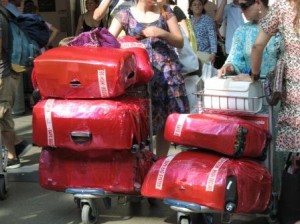 Take the check-in area on the Departures level. It is beautifully long, but ludicrously narrow. There are 60 check-in counters, and the designer(s) evidently assumed that each check-in counter would serve a line of no more than 25 calm, lucid, well-organized passengers with no luggage or children. Then they left just a smidge of space at the end of the line so that people could get through who needed to go somewhere else — another counter, or the newsstand or the bar.
Take the check-in area on the Departures level. It is beautifully long, but ludicrously narrow. There are 60 check-in counters, and the designer(s) evidently assumed that each check-in counter would serve a line of no more than 25 calm, lucid, well-organized passengers with no luggage or children. Then they left just a smidge of space at the end of the line so that people could get through who needed to go somewhere else — another counter, or the newsstand or the bar.